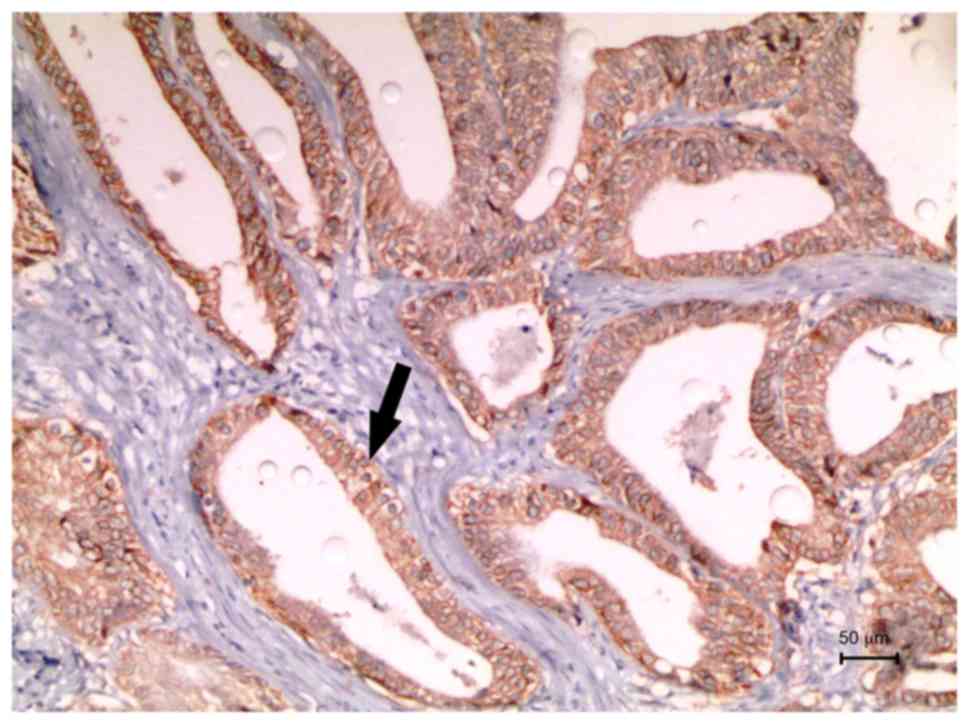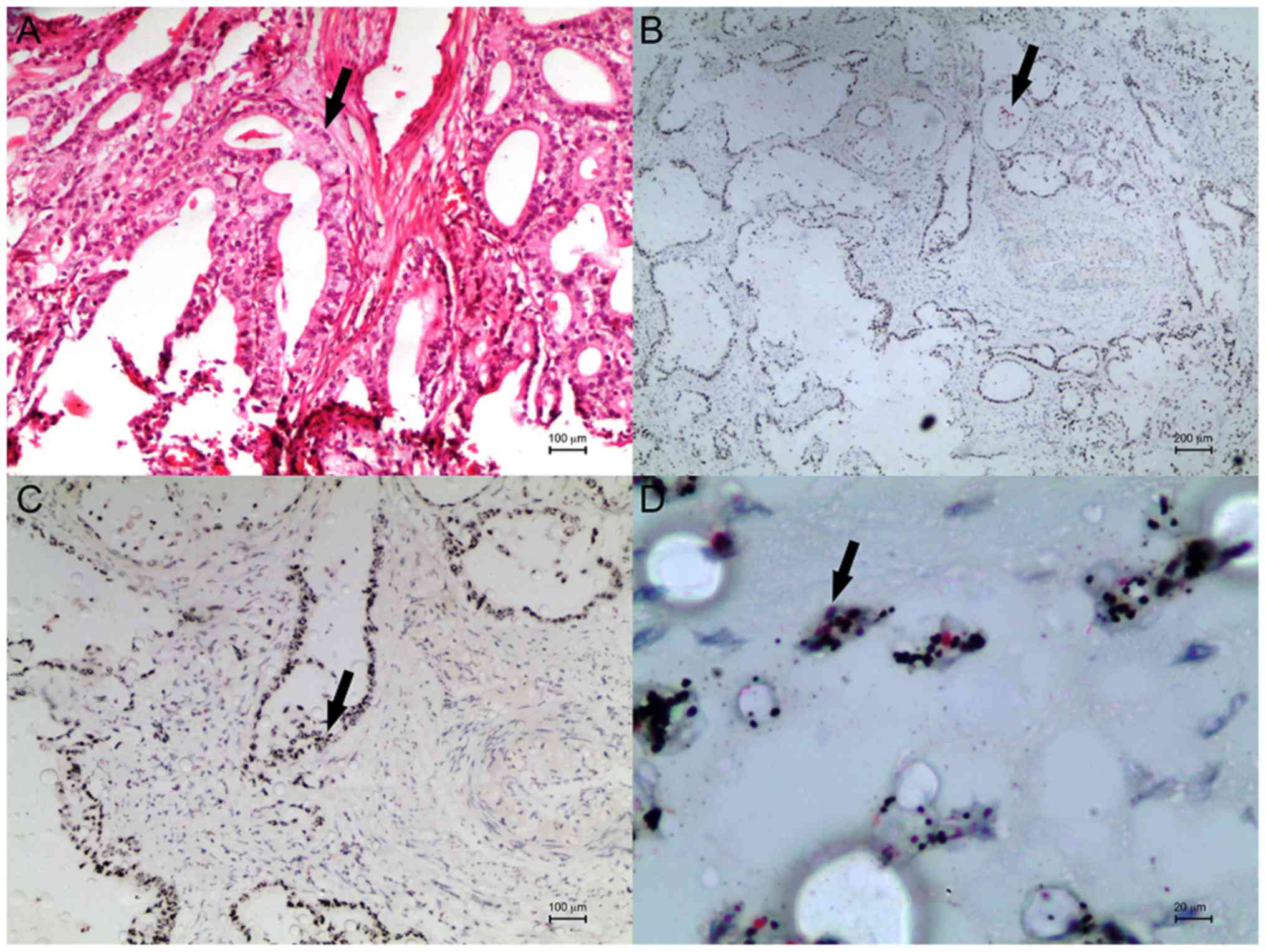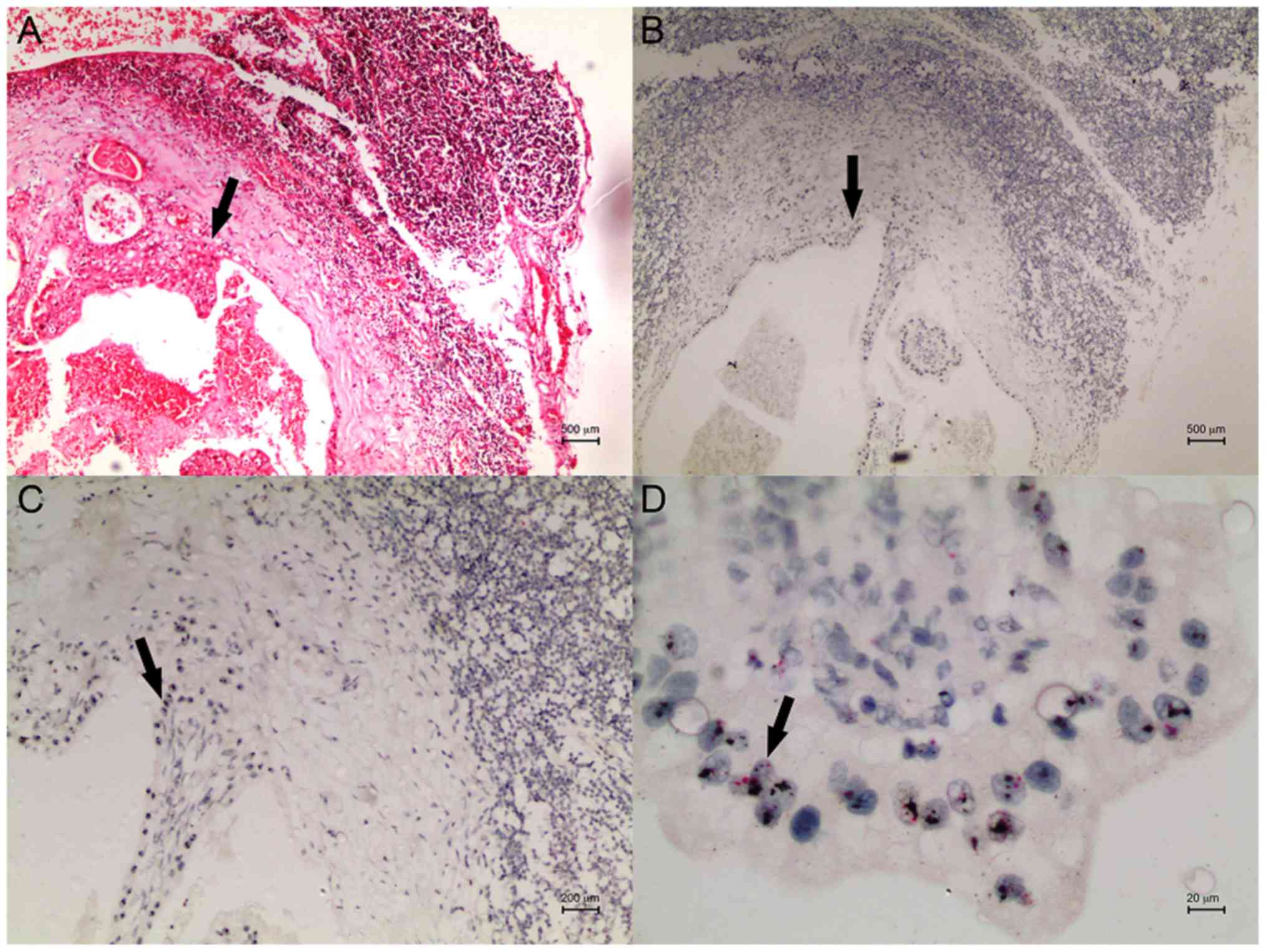|
1
|
Bray F, Ferlay J, Soerjomataram I, Siegel
RL, Torre LA and Jemal A: Global cancer statistics 2018: GLOBOCAN
estimates of incidence and mortality worldwide for 36 cancers in
185 countries. CA Cancer J Clın. 68:394–424. 2018. View Article : Google Scholar
|
|
2
|
Tanner M, Hollmén M, Junttila TT, Kapanen
AI, Tommola S, Soini Y, Helin H, Salo J, Joensuu H, Sihvo E, et al:
Amplification of HER-2 in gastric carcinoma: Association with
Topoisomerase IIalpha gene amplification, intestinal type, poor
prognosis and sensitivity to trastuzumab. Ann Oncol. 16:273–278.
2005. View Article : Google Scholar : PubMed/NCBI
|
|
3
|
Jørgensen JT and Hersom M: HER2 as a
prognostic marker in gastric cancer-a systematic analysis of data
from the literature. J Cancer. 3:137–144. 2012. View Article : Google Scholar : PubMed/NCBI
|
|
4
|
Park DI, Yun JW, Park JH, Oh SJ, Kim HJ,
Cho YK, Sohn CI, Jeon WK, Kim BI, Yoo CH, et al: HER-2/neu
amplification is an independent prognostic factor in gastric
cancer. Dig Dis Sci. 51:1371–1379. 2006. View Article : Google Scholar : PubMed/NCBI
|
|
5
|
Bang YJ, Van Cutsem E, Feyereislova A,
Chung HC, Shen L, Sawaki A, Lordick F, Ohtsu A, Omura Y, Satoh T,
et al: ToGA Trial Investigators. Trastuzumab in combination with
chemotherapy versus chemotherapy alone for treatment of
HER2-positive advanced gastric or gastro-oesophageal junction
cancer (ToGA): A phase 3, open-label, randomised controlled trial.
Lancet. 376:687–697. 2010. View Article : Google Scholar : PubMed/NCBI
|
|
6
|
Cortés-Funes H, Rivera F, Alés I, Márquez
A, Velasco A, Colomer R, García-Carbonero R, Sastre J, Guerra J and
Grávalos C: Phase II of trastuzumab and cisplatin in patients with
advanced gastric cancer with HER2/neu overexpression/amplification.
J Clin Oncol. 25 (Suppl 18):46132007. View Article : Google Scholar
|
|
7
|
Marx AH, Tharun L, Muth J, Dancau AM,
Simon R, Yekebas E, Kaifi JT, Mirlacher M, Brümmendorf TH,
Bokemeyer C, et al: HER-2 amplification is highly homogenous in
gastric cancer. Hum Pathol. 40:769–777. 2009. View Article : Google Scholar : PubMed/NCBI
|
|
8
|
Takehana T, Kunitomo K, Kono K, Kitahara
F, Iizuka H, Matsumoto Y, Fujino MA and Ooi A: Status of c-erbB-2
in gastric adenocarcinoma: A comparative study of
immunohistochemistry, fluorescence in situ hybridization and
enzyme-linked immuno-sorbent assay. Int J Cancer. 98:833–837. 2002.
View Article : Google Scholar : PubMed/NCBI
|
|
9
|
Hofmann M, Stoss O, Shi D, Büttner R, van
de Vijver M, Kim W, Ochiai A, Rüschoff J and Henkel T: Assessment
of a HER2 scoring system for gastric cancer: Results from a
validation study. Histopathology. 52:797–805. 2008. View Article : Google Scholar : PubMed/NCBI
|
|
10
|
Kim MA, Lee HJ, Yang HK, Bang YJ and Kim
WH: Heterogeneous amplification of ERBB2 in primary lesions is
responsible for the discordant ERBB2 status of primary and
metastatic lesions in gastric carcinoma. Histopathology.
59:822–831. 2011. View Article : Google Scholar : PubMed/NCBI
|
|
11
|
Francis GD, Jones MA, Beadle GF and Stein
SR: Bright-field in situ hybridization for HER2 gene amplification
in breast cancer using tissue microarrays: Correlation between
chromogenic (CISH) and automated silver-enhanced (SISH) methods
with patient outcome. Diagn Mol Pathol. 18:88–95. 2009. View Article : Google Scholar : PubMed/NCBI
|
|
12
|
Ross JS, Slodkowska EA, Symmans WF,
Pusztai L, Ravdin PM and Hortobagyi GN: The HER-2 receptor and
breast cancer: Ten years of targeted anti-HER-2 therapy and
personalized medicine. Oncologist. 14:320–368. 2009. View Article : Google Scholar : PubMed/NCBI
|
|
13
|
Yano T, Doi T, Ohtsu A, Boku N, Hashizume
K, Nakanishi M and Ochiai A: Comparison of HER2 gene amplification
assessed by fluorescence in situ hybridization and HER2 protein
expression assessed by immunohistochemistry in gastric cancer.
Oncol Rep. 15:65–71. 2006.PubMed/NCBI
|
|
14
|
Grabsch H, Sivakumar S, Gray S, Gabbert HE
and Müller W: HER2 expression in gastric cancer: Rare,
heterogeneous and of no prognostic value- conclusions from 924
cases of two independent series. Cell Oncol. 32:57–65.
2010.PubMed/NCBI
|
|
15
|
Drev P, Grazio SF and Bracko M: Tissue
microarrays for routine diagnostic assessment of HER2 status in
breast carcinoma. Appl Immunohistochem Mol Morphol. 16:179–184.
2008. View Article : Google Scholar : PubMed/NCBI
|
|
16
|
Simon R, Nocito A, Hübscher T, Bucher C,
Torhorst J, Schraml P, Bubendorf L, Mihatsch MM, Moch H, Wilber K,
et al: Patterns of Her-2/neu amplification and overexpression in
primary and metastatic breast cancer. J Natl Cancer Inst.
93:1141–1146. 2001. View Article : Google Scholar : PubMed/NCBI
|
|
17
|
Bozzetti C, Negri FV, Lagrasta CA, Crafa
P, Bassano C, Tamagnini I, Gardini G, Nizzoli R, Leonardi F,
Gasparro D, et al: Comparison of HER2 status in primary and paired
metastatic sites of gastric carcinoma. Br J Cancer. 104:1372–1376.
2011. View Article : Google Scholar : PubMed/NCBI
|
|
18
|
Kochi M, Fujii M, Masuda S, Kanamori N,
Mihara Y, Funada T, Tamegai H, Watanabe M, Suda H and Takayama T:
Differing deregulation of HER2 in primary gastric cancer and
synchronous related metastatic lymph nodes. Diagn Pathol.
8:1912013. View Article : Google Scholar : PubMed/NCBI
|
|
19
|
Ieni A, Barresi V, Caltabiano R, Caleo A,
Bonetti LR, Lanzafame S, Zeppa P, Caruso RA and Tuccari G:
Discordance rate of HER2 status in primary gastric carcinomas and
synchronous lymph node metastases: A multicenter retrospective
analysis. Int J Mol Sci. 15:22331–22341. 2014. View Article : Google Scholar : PubMed/NCBI
|
|
20
|
Pagni F, Zannella S, Ronchi S, Garanzini C
and Leone BE: HER2 status of gastric carcinoma and corresponding
lymph node metastasis. Pathol Oncol Res. 19:103–109. 2013.
View Article : Google Scholar : PubMed/NCBI
|
|
21
|
Bosman FT, Carneiro F, Hruban RH and
Theise ND: World Health Organisation classification of tumors of
the digestive system. IARC; Lyon: 2010
|
|
22
|
Simon R, Mirlacher M and Sauter G: Tissue
microarrays. Methods Mol Med. 114:257–268. 2005.PubMed/NCBI
|
|
23
|
David L, Seruca R, Nesland JM, Soares P,
Sansonetty F, Holm R, Børresen AL and Sobrinho-Simões M: C-erbB-2
expression in primary gastric carcinomas and their metastases. Mod
Pathol. 5:384–390. 1992.PubMed/NCBI
|
|
24
|
Asioli S, Maletta F, Verdun di Cantogno L,
Satolli MA, Schena M, Pecchioni C, Botta C, Chiusa L, Molinaro L,
Conti L, et al: Approaching heterogeneity of human epidermal growth
factor receptor 2 in surgical specimens of gastric cancer. Hum
Pathol. 43:2070–2079. 2012. View Article : Google Scholar : PubMed/NCBI
|
|
25
|
Ge X, Wang H, Zeng H, Jin X, Sujie A, Xu
C, Liu Y, Huang J, Ji Y, Tan Y, et al: Clinical significance of
assessing Her2/neu expression in gastric cancer with dual tumor
tissue paraffin blocks. Hum Pathol. 46:850–857. 2015. View Article : Google Scholar : PubMed/NCBI
|
|
26
|
National Comprehensive Cancer Network
clinical practice guidelines in oncology (version 2.2015), .
Gastric cancer.
|
|
27
|
Tominaga N, Gotoda T, Hara M, Hale MD,
Tsuchiya T, Matsubayashi J, Kono S, Kusano C, Itoi T, Fujimoto K,
et al: Five biopsy specimens from the proximal part of the tumor
reliably determine HER2 protein expression status in gastric
cancer. Gastric Cancer. 19:553–560. 2016. View Article : Google Scholar : PubMed/NCBI
|
|
28
|
Warneke VS, Behrens HM, Böger C, Becker T,
Lordick F, Ebert MPA and Röcken C: Her2/neu testing in gastric
cancer: Evaluating the risk of sampling errors. Ann Oncol.
24:725–733. 2013. View Article : Google Scholar : PubMed/NCBI
|
|
29
|
Stahl P, Seeschaaf C, Lebok P, Kutup A,
Bockhorn M, Izbicki JR, Bokemeyer C, Simon R, Sauter G and Marx AH:
Heterogeneity of amplification of HER2, EGFR, CCND1 and MYC in
gastric cancer. BMC Gastroenterol. 15:72015. View Article : Google Scholar : PubMed/NCBI
|
|
30
|
Werner D, Battmann A, Steinmetz K, Jones
T, Lamb T, Martinez M, Altmannsberger HM and Al-Batran SE: The
validation of a novel method combining both HER2
immunohistochemistry and HER2 dual-colour silver in situ
hybridization on one slide for gastric carcinoma testting. J Transl
Med. 12:1602014. View Article : Google Scholar : PubMed/NCBI
|
|
31
|
Kim MA, Jung JE, Lee HE, Yang HK and Kim
WH: In situ analysis of HER2 mRNA in gastric carcinoma: Comparison
with fluorescence in situ hybridization, dual-color silver in situ
hybridization, and immunohistochemistry. Hum Pathol. 44:487–494.
2013. View Article : Google Scholar : PubMed/NCBI
|
|
32
|
Fusco N, Rocco EG, Del Conte C, Pellegrini
C, Bulfamante G, Nuovo FD, Romagnoli S and Bosari S: HER2 in
gastric cancer: A digital image analysis in pre-neoplastic, primary
and metastatic lesions. Mod Pathol. 26:816–824. 2013. View Article : Google Scholar : PubMed/NCBIPubMed/NCBIPubMed/NCBIPubMed/NCBIPubMed/NCBIPubMed/NCBIPubMed/NCBIPubMed/NCBIPubMed/NCBIPubMed/NCBIPubMed/NCBIPubMed/NCBIPubMed/NCBI
|

















